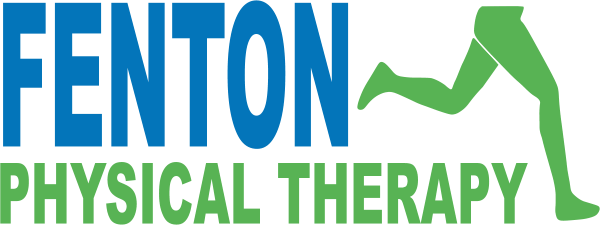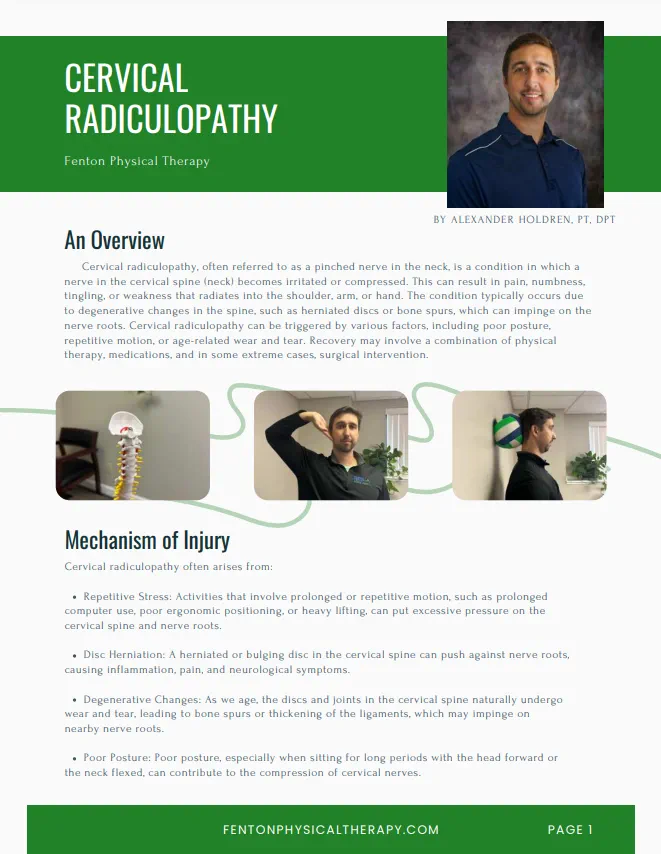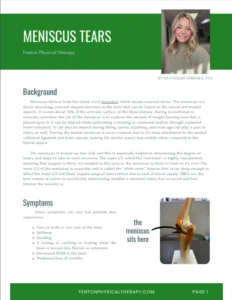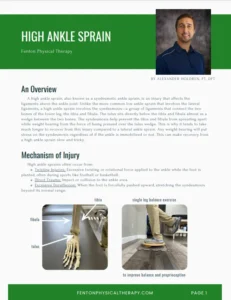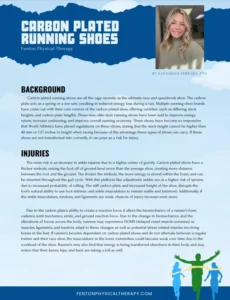An Overview
Cervical radiculopathy, often referred to as a pinched nerve in the neck, is a condition in which a nerve in the cervical spine (neck) becomes irritated or compressed. This can result in pain, numbness, tingling, or weakness that radiates into the shoulder, arm, or hand. The condition typically occurs due to degenerative changes in the spine, such as herniated discs or bone spurs, which can impinge on the nerve roots. Cervical radiculopathy can be triggered by various factors, including poor posture, repetitive motion, or age-related wear and tear. Recovery may involve a combination of physical therapy, medications, and in some extreme cases, surgical intervention.
DOWNLOAD THE PDF TO VIEW THE ILLUSTRATIONS
Mechanism of Injury
Cervical radiculopathy often arises from:
- Repetitive Stress: Activities that involve prolonged or repetitive motion, such as prolonged computer use, poor ergonomic positioning, or heavy lifting, can put excessive pressure on the cervical spine and nerve roots.
- Disc Herniation: A herniated or bulging disc in the cervical spine can push against nerve roots, causing inflammation, pain, and neurological symptoms.
- Degenerative Changes: As we age, the discs and joints in the cervical spine naturally undergo wear and tear, leading to bone spurs or thickening of the ligaments, which may impinge on nearby nerve roots.
- Poor Posture: Poor posture, especially when sitting for long periods with the head forward or the neck flexed, can contribute to the compression of cervical nerves.
Recovery Timeline
- (1-2 Weeks): The initial focus is on managing pain and inflammation. Rest, ice, and antiinflammatory medications are typically recommended. Avoiding activities that exacerbate
symptoms, such as heavy lifting or sustained neck positions, is critical during this period. - (2-6 Weeks): Gentle stretching and strengthening exercises are gradually introduced to improve neck mobility and alleviate pressure on the nerve roots. Physical therapy focuses on posture correction and muscle strengthening around the cervical spine to support proper alignment.
- (6-12 Weeks): The emphasis shifts to functional exercises, including more advanced strengthening routines, improving flexibility, and preventing re-injury. Activity modification may be required to ensure proper biomechanics during daily activities.
- (12 Weeks +): Most individuals experience significant improvement in symptoms, though recovery times can vary based on the severity of the nerve compression and how diligently the rehabilitation program is followed.
What to Expect in a Physical Therapy Session
- History and Evaluation: Discussion of your symptoms, activity history, and any factors contributing to the development of cervical radiculopathy.
- Physical Examination: Assessment of neck range of motion, strength, and neurological signs (such as reflex changes or sensory deficits).
- Modalities: Ice, or heat therapy to reduce pain and inflammation in the neck area.
- Gentle Stretching: Focused on improving flexibility in the neck, upper back, and shoulders to alleviate pressure on the nerve roots.
- Strengthening Exercises: Targeted at improving strength in the neck muscles, upper back, and core muscles to stabilize the cervical spine and prevent future nerve compression.
- Postural and Biomechanical Education: Guidance on improving posture and body mechanics to prevent further stress on the cervical spine. Proper ergonomic adjustments at work or during sleep may be emphasized.
- Activity Modification: Advice on modifying activities to reduce neck strain, such as adjusting sitting positions, using supportive pillows, or avoiding prolonged neck flexion.
- Injury Prevention: Techniques to prevent recurrence, such as gradually increasing activity intensity and performing strengthening exercises regularly.
Summary
Cervical radiculopathy can be a debilitating condition, but with a structured approach to recovery, most individuals can experience significant improvement. Physical therapy plays a key role in relieving symptoms by addressing the underlying causes, such as poor posture, muscle imbalances, or spinal degeneration. Adherence to a rehabilitation program, including stretching, strengthening, and postural correction, is essential for a full recovery and long-term prevention of future nerve issues.
